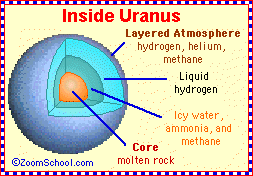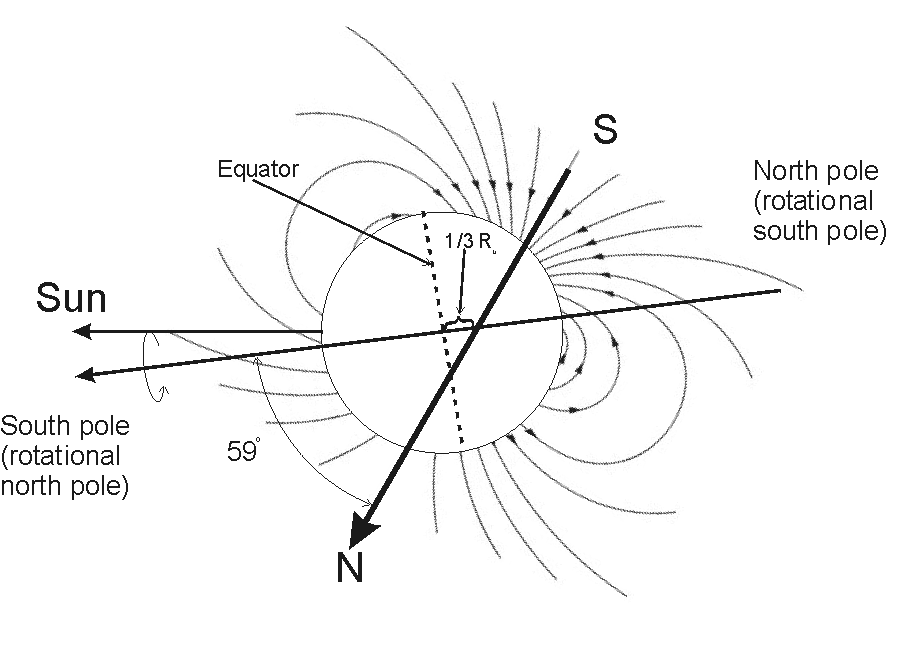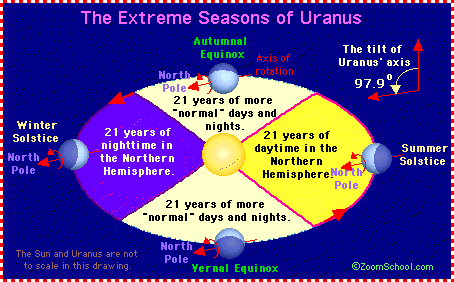
About Uranus: Pronounced- " YOOR a nus"
It all started back in 1781 when Uranus was discovered by the astronomer William Herschel with aid of a telescope. Uranus was seen many times before but others ignored it thinking that it simply was a star. The planet has only been visited once before by a spacecraft named voyager 2 in January 24, 1986. It is the seventh planet from the sun and is the third largest by diameter. It consists of some of the brightest clouds in our outer solar system and has11 rings. It has no solid surface and belongs as part of the group of the gas planets. The Planet is so far away, that it takes eighty-four years to complete one orbit.


William Herschel Voyager 2

Its atmosphere is mainly made of hydrogen and helium, with a small amount of methane and traces of water and ammonia. It gets its vividly blue-green color from the methane gas because as the sunlight passes through, it is reflected by the clouds, which lie beneath a layer of methane gas. As the reflected sunlight passes back through this layer, the methane gas absorbs the red portion of the light, allowing the blue portion to pass through, resulting in the blue-green color that we see. About eighty percent of the mass of Uranus is contained in an extended liquid core consisting primarily of 'icy' materials (water, methane, and ammonia),

Uranus' rotation axis is nearly horizontal as though Uranus has been knocked on its side, as compared to most other planets in our solar system so it is nearly parallel to the elliptic. This may have resulted from a collision with a planet-size body in its early history. In addition, its magnetic field is tipped over. Instead of it usually being aligned with the rotational axis, the magnetic axis is tilted nearly 60 degrees from the planet's axis of rotation. The magnetic fields of Uranus are irregular because the plants’ polar regions receive more energy from the sun which makes the magnetic field about forty-eight times stronger than earths.


One effect from the planet being tipped over to the side causes an orbit to last over eighty years and days to last seventeen hours and fourteen minutes long. But since it is so far away from the sun, the temperatures of summer and winter do not differ so greatly.


Uranus has twenty-seven known moons with Oberon and Titania being the largest discovered. Many of them are made of ice and rock with many fascinating surface features. Since the moons have no atmosphere and magnetosphere, the chances of life are slim.

Recent reasearch:
Besides the information we have learned from voyager 2, there are no plans to sending any kinds of spacecraft back to uranus.
Future Experiments:
As for voyager 2, it was very successful in capturing images of this mysterious planet. In future experiments, we need to create a spacecraft or probe that can be sent out to space where once it reaches Uranus, can capture thousands of photos. Once reaching the inner surface, we need the probe to predict a landing area where it can actually capture images while walking on its surface. Possibily, the probe should have a drilling tool to drill down the mantle eventually reaching the core the and take samples of the different interiors to have a better understanding.
The probe would also be able to collect certain rocks so that we have test, we would be able to predict the radioactive ages of the rocks. It would also be interesting if we were able to collect ice from the planet.
While This experiment is taking place, the questions I want to ask myself are:
- Why doesn't Uranus radiate more heat than it receives from the Sun as the other gas planets do? Is its interior cold?
-
- Why is its axis so unusually tilted? Was it due to a massive collision?
- What will happen as Uranus's progresses thorugh its season?

Experiment two:
Sending a probe to uranus's moons should also be helpful to our knowledge. Since the moons consist of no atmosphere and magnetosphere it should't be as hard to land on one of its moons. Though, we will need a probe that can stand the cold weather.
Certain questions I would like to answer about the moon are
- How were the moons created? Was it a massive collision? is it like earth where the moon started as a sea of magma?
- were any or all of the moons active?
Images taken from the moon can be used to observe differet crater which may give us an idea of its age.

Sources:
http://en.wikipedia.org/wiki/Uranus
http://www.bbc.co.uk/science/space/solarsystem/uranus/index.shtml
http://www.alexmeske.com/Essays/uranus.htm
http://www.enchantedlearning.com/subjects/astronomy/planets/uranus/
http://solarsystem.nasa.gov/missions/future1.cfm
Photo credits:
http://www.enchantedlearning.com/ugifs/Uranusseasons.GIF
http://www.saskschools.ca/~gregory/space/planets/uranus1.jpg
http://www.shatters.net/celestia/images/gallery/voyager2-neptune.jpg
http://www.strudel.org.uk/blog/astro/images/20050524_uranus_eso.jpg
http://dragonphysics.pbwiki.com/f/Uranus%20from%20Ariel.jpg
http://www.crystalinks.com/uranus.jpg
http://www.ssec.wisc.edu/media/spotlight/images/dark_spot_on_Uranus-prc06-47.jpg
http://z.about.com/d/space/1/0/Y/3/uranus1.jpg
Comments (6)
Artemis rafti said
at 8:23 pm on Jan 9, 2009
I think this is a very good job. One thing I noticed...the third picture near the top with "Voyager 2" under it, is Voyager 2 passing by NEPTUNE not Uranus. Neptune has the Great Dark Spot on it (storm)...but I don't blame you lol.
Dave Goldberg said
at 5:49 pm on Jan 6, 2009
I've seen better. Just playin it's a pretty good project. It taught me things I didn't know about Uranus like how it rotates on its side. It looks like you spent a lot of time on this.
Ivanna Subbotina said
at 5:17 pm on Jan 6, 2009
The information about the planet was very nicely done and it is clearly shown that you did a lot of research.
Concerning the experiments, the ideas behind them are unique and very original, but they do seem to be very vague.
stephen labarge said
at 11:08 pm on Jan 4, 2009
very well put together with extensive research. I like the use of alot of pictures to illustrate your points. Your experiments were very thought out and plausible.
gemma said
at 3:04 pm on Jan 2, 2009
This page has a lot of good pictures. The questions to be used for experiments are also all good, and show that you know what you are talking about. One thing I was confused about was how the weird orientation of the planet affects the length of the year and day, so I wish that was more explained.
Nayan Walia said
at 10:48 am on Dec 30, 2008
Reading this page was really interesting. I think you did a reaaly good job, and your reseach shows it. Maybe one thing you could have tried to do better is putting your infor mation in sections and heading them. They might help the reader a little.
You don't have permission to comment on this page.